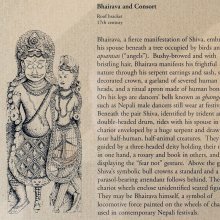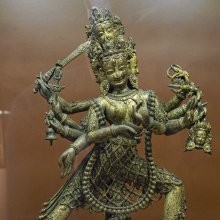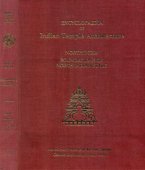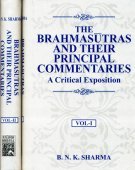Manifest, Manifested, Manifestation, Manifesting: 2 definitions
Introduction:
Manifest means something in Hinduism, Sanskrit. If you want to know the exact meaning, history, etymology or English translation of this term then check out the descriptions on this page. Add your comment or reference to a book if you want to contribute to this summary article.
Images (photo gallery)
(+27 more images available)
In Hinduism
Vedanta (school of philosophy)
Source: ORA: Amanaska (king of all yogas): (Advaita Vedanta)(That which) Manifested (all at once) is denoted by the Sanskrit term Vibhāta, according to the Māṇḍūkyopaniṣatkārikā 3.35cd-36.—Accordingly, while discussing Brahma (without attributes): “That very [mind, free of thought and restrained,] is fearless Brahma, [which is] the light of gnosis [pervading] everywhere. [It is] unborn, devoid of sleep and dreaming, unnamed, formless, manifested [all] at once (sakṛd-vibhāta) and omniscient. [This statement] is not figurative in any way”.

Vedanta (वेदान्त, vedānta) refers to a school of orthodox Hindu philosophy (astika), drawing its subject-matter from the Upanishads. There are a number of sub-schools of Vedanta, however all of them expound on the basic teaching of the ultimate reality (brahman) and liberation (moksha) of the individual soul (atman).
Yoga (school of philosophy)
Source: ORA: Amanaska (king of all yogas): A Critical Edition and Annotated Translation by Jason Birch1) The Manifestation (of the Amanaska-Mudrā) is denoted by the Sanskrit term Āvis, according to the Yogatārāvalī: a short Yoga text of twenty-nine verses presenting Haṭhayoga as the means to Rājayoga (i.e., Samādhi).—Accordingly, while describing the no-mind state: “We see the Amanaska Mudrā manifesting (āvis—āvirbhavantīm) in [those] most eminent sages because [their] breathing has disappeared, [their] bodies are firm and [their] lotus-eyes are half closed”.
2) (Making) Manifest (the highest reality) is denoted by the Sanskrit term Prakāśana, according to the Amanaska Yoga treatise dealing with meditation, absorption, yogic powers and liberation.—Accordingly, as Īśvara says to Vāmadeva: “[...] [Now], I will teach the practice of that, which produces absorption. [...] Sitting evenly on a comfortable seat, one should accomplish the practice of [eliminating] the [lower] Tattvas. Through constant practice, [the Yogin] should make manifest (prakāśana) the highest reality. [...]”.

Yoga is originally considered a branch of Hindu philosophy (astika), but both ancient and modern Yoga combine the physical, mental and spiritual. Yoga teaches various physical techniques also known as āsanas (postures), used for various purposes (eg., meditation, contemplation, relaxation).
See also (Relevant definitions)
Ends with: Unmanifest.
Full-text (+3194): Pradurbhava, Vyakta, Avirbhava, Prakasha, Prakata, Prakashana, Avishkarana, Prakatita, Avishkrita, Prakashita, Pradurbhuta, Prakatikarana, Abhivyakti, Avirbhuta, Vyanjita, Vyakti, Avabhasa, Suvyakta, Agudha, Udbhavana.
Relevant text
Search found 416 books and stories containing Manifest, Manifested, Manifestation, Manifesting; (plurals include: Manifests, Manifesteds, Manifestations, Manifestings). You can also click to the full overview containing English textual excerpts. Below are direct links for the most relevant articles:
Brahma Sutras (Ramanuja) (by George Thibaut)
The view that the conscious subject is something unreal, due to the ahamkara, cannot be maintained < [First Adhyaya, First Pada]
Sutra 4.4.3 < [Fourth Adhyaya, Fourth Pada]
Sutra 4.4.1 < [Fourth Adhyaya, Fourth Pada]
A History of Indian Philosophy Volume 4 (by Surendranath Dasgupta)
Part 2 - The nature of Brahman < [Chapter XXXI - The Philosophy of Vallabha]
Part 2 - Nature of Knowledge < [Chapter XXIX-XXX - Controversy Between the Dualists and the Monists]
Part 6 - Inference of ajñāna < [Chapter XXIX-XXX - Controversy Between the Dualists and the Monists]
Brihad Bhagavatamrita (commentary) (by Śrī Śrīmad Bhaktivedānta Nārāyana Gosvāmī Mahārāja)
Verse 2.2.214 < [Chapter 2 - Jñāna (knowledge)]
Preface to the First Hindi Edition [Volume 2]
Verse 2.4.158 < [Chapter 4 - Vaikuṇṭha (the spiritual world)]
A History of Indian Philosophy Volume 3 (by Surendranath Dasgupta)
Part 1 - Yāmuna’s doctrine of Soul contrasted with those of others < [Chapter XIX - The Philosophy of Yāmunācārya]
Part 17 - Rāmānujācārya II alias Vādi-Haṃsa-Navāmvuda < [Chapter XX - Philosophy of the Rāmānuja School of Thought]
Part 5 - Philosophy of the Ahirbudhnya-saṃhitā < [Chapter XVI - The Pañcarātra]
Guhyagarbha Tantra (with Commentary) (by Gyurme Dorje)
Commentary 3.1: The Recognition of the Maṇḍala < [Chapter 15 (Text and Commentary)]
Text 15.32 (Commentary) < [Chapter 15 (Text and Commentary)]
Introduction 2: (Inconceivable Emanations) < [Chapter 3 (text and commentary)]
Shrimad Bhagavad-gita (by Narayana Gosvami)
Verse 11.46 < [Chapter 11 - Viśvarūpa-darśana-yoga (beholding the Lord’s Universal Form)]
Verse 4.6 < [Chapter 4 - Jñāna-Yoga (Yoga through Transcendental Knowledge)]
Verse 10.2 < [Chapter 10 - Vibhūti-yoga (appreciating the opulences of the Supreme Lord)]
Related products
(+14 more products available)










